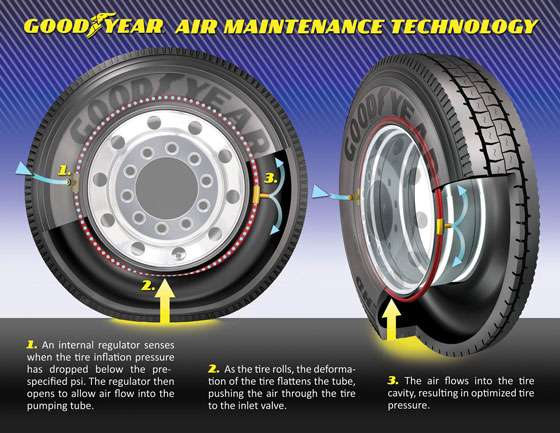
Quando a pressão cai abaixo de um certo parâmetro, o regulador abre uma entrada de ar para dentro do pneu. Um tubo, que percorre toda a circunferência do pneu, é pressionado pela parte murcha do pneu que está em contato com o solo, com isso, suga o ar de fora para dentro do pneu.
Quando o pneu atingir a pressão correta, o regulador se fecha, encerrando o ciclo de calibração automática do pneu. A operação não requer paradas de emergência e nem que um compressor externo esteja presente no veículo.
Quando a pressão de um pneu está abaixo da ideal, o consumo de combustível aumenta e o desgaste da banda de rodagem é acelerado. A Goodyear diz que a implementação do Air Maintenance Technology em veículos comerciais estava difícil, devido à pressão exercida nos pneus, que é por volta de 105 psi, mais que o triplo que a aplicada nos carros de passeio, que é 32 psi.
Debut of Goodyear Self-Inflating Technology for Commercial Tires at the Internationale Automobil-Ausstellung (IAA) Commercial Vehicle Show
Goodyear technology can aid in fuel savings and CO2 reductions; potential to improve performance and eliminate need for external inflation pressure intervention.
AKRON, Ohio, Sept. 19, 2012 -- Over the past year, researchers at The Goodyear Tire & Rubber Company (NYSE: GT) have been working on a new Air Maintenance Technology application that can aid in fuel savings and CO2 reductions while potentially improving performance and eliminating need for external inflation pressure intervention. The commercial application of Goodyear's Air Maintenance Technology will make its debut at the 2012 Internationale Automobil-Ausstellung (IAA) Commercial Vehicle Show in Hanover, Germany.
Tire-related costs are the single largest maintenance item for commercial vehicle fleet operators with more than 50 percent of all truck and trailer breakdowns involving a tire in some way[1]. Goodyear's Air Maintenance Technology mechanism allows tires to maintain constant, optimum pressure without the use of external pumps, electronics and driver intervention.
Proper tire inflation can result in improved fuel economy, prolonged tread life and optimized tire performance. Customers should receive the following key benefits from Air Maintenance Technology-enabled tires:
Improved Fuel Economy
Optimum tire pressure is key in the commercial market. It is estimated that for every 10 psi lost in tire inflation, there is a one percent[2] loss in miles per gallon.
While one percent may seem insignificant, it could cost a truck owner over $627.00 in fuel, based on a vehicle that has a fuel consumption of 6.6 miles per gallon, runs 100,000 miles a year with a diesel fuel price of $4.10/gallon[3].
Prolonged Tread Life
AMT is expected to play a major role in optimizing tread life in the commercial tire market. Tires which are under inflated by ten percent decrease tread life by 9-16 percent[4]. By utilizing Goodyear's Air Maintenance Technology, commercial vehicle fleet operators will be able to realize the full mileage potential of their tires, thus saving money by prolonging the use of their tires.
Optimized Performance
Properly inflated tires are also necessary to keep a vehicle's handling performance at optimal levels. Under-inflation means less evenly distributed pressure on the road. It also reduces the tread area that is in direct contact with the road and can impact the integrity of the tire casing, which is key to the retreading process.
Commercial trucks pose a different challenge for AMT than that of consumer vehicles as their tires are larger, have higher inflation pressures, drive longer distances and carry much heavier loads. Commercial tires operate at a higher air pressure, typically 105 psi for commercial tires vs. 32 psi for consumer tires. This is a much more challenging performance requirement for the pump system. The life of a commercial truck tire is often extended by retreading. The commercial truck AMT system is being designed to perform after the retreading process.
"We believe the Air Maintenance Technology application for commercial vehicle tires will not only enhance the performance of the tire, but will also provide cost savings to fleet owners and operators through the extension of tire tread life and increased fuel economy" stated Goodyear's Chief Technical Officer, Jean-Claude Kihn. "The progress we continue to make with this technology is very encouraging. We look forward to further testing of this concept."
Engineers at Goodyear's Innovation Center in Akron, Ohio, USA are credited with the development of the commercial application of this concept and the supporting technology. Prototype tires have been produced in Goodyear's Topeka manufacturing plant in Kansas, USA, and rigorous validation testing has confirmed that the AMT pumping mechanism works. An extensive fleet trial is planned to gather real-world information from customers in 2013.
A $1.5 million grant from The United States Department of Energy's Office (DOE) of Vehicle Technology is helping speed up research, development and demonstration of the AMT system for commercial vehicle tires. A grant from the Luxembourg government for research and development will continue to help fund Goodyear's efforts in researching and developing the AMT system for consumer tires.

Postar um comentário